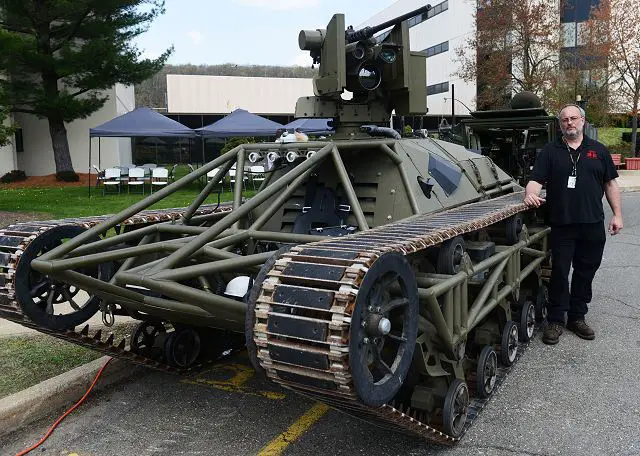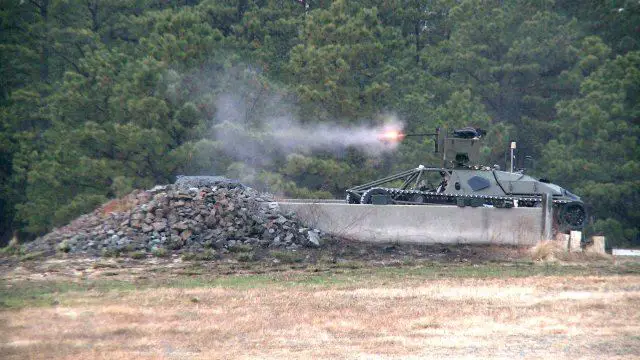|
|
|||
|
Military Defense Industry Technology - Ripsaw UGV
|
|||
|
|
|||
| Ripsaw unmanned ground vehicle could lead U.S. army combat formation across enemy terrain. | |||
|
The Ripsaw Unmanned Ground Vehicle (UGV) might someday take point and lead Army combat formations across enemy terrain. Testa, lead engineer for the Remote Weapons Branch of the Armament Research, Development and Engineering Center, or ARDEC, showcased the Ripsaw on media day at Picatinny Arsenal, May 4.
|
|||
|
|
|||
 Bob Testa, lead engineer for the Remote Weapons Branch of the Armament Research, Development and Engineering Center, poses beside the Ripsaw Unmanned Ground Vehicle during media day at Picatinny Arsenal, N.J., May 4, 2015. Bob Testa, lead engineer for the Remote Weapons Branch of the Armament Research, Development and Engineering Center, poses beside the Ripsaw Unmanned Ground Vehicle during media day at Picatinny Arsenal, N.J., May 4, 2015. |
|||
|
|
|||
|
During tests, the Ripsaw was followed by an M113 Armored Personnel Carrier. Trailing up to a kilometer behind, the M113 was driven by a Soldier. Another Soldier, in the vehicle, would control the Ripsaw and its weapon wirelessly, Testa said. CROWS has been used in combat as far back as 2004 in Iraq. Testa's team supported that initiative, fielding more than 10,000, he said. CROWS allows a Soldier inside a tank, Humvee, Stryker or any other vehicle to fire his weapon safely from inside the armor-protected vehicle. In other words, he does not have to stick his head out to see to fire. Cameras and range finders on CROWS see for him and the system can tilt and swivel the weapon as needed. |
|||
|
|
|||
 The Ripsaw Unmanned Ground Vehicle engages a target at a distance of 700 meters, using the M2 .50 caliber machine gun. The Ripsaw Unmanned Ground Vehicle engages a target at a distance of 700 meters, using the M2 .50 caliber machine gun. |
|||
|
|
|||
|
While that capability probably resulted in a lot of saved lives, the Soldier inside the vehicle could still be killed or injured from a large enemy mine or projectile. So Testa's team took the remotely-operated system one step further. They completely removed the Soldier from the vehicle.
The weakness of the entire system was the weapon itself, he said, meaning the M2 .50-caliber machine gun, Mk19 40-mm automatic grenade machine gun, M240B 7.62 mm machine gun, M249 Squad Automatic Weapon, or any number of other weapons that can be mounted in CROWS. So the next step for his team was to design a weapon to fire remotely. ARDEC developed the Advanced Remote Armament System, or ARAS, a gun that self-loads its own ammunition and even can swap out various types of ammunition, such as lethal and non-lethal, in just a few seconds, he said. The Ripsaw is a developmental unmanned light tank designed and built by Howe & Howe Technologies for evaluation by the United States Army. The Ripsaw is intended to perform various missions including convoy protection, perimeter defense, surveillance, rescue, border patrol, crowd control, and explosive ordnance disposal. For perimeter defense or crowd control, a belt of M5 Modular Crowd Control Munitions (MCCM) can be mounted around the vehicle to break up crowds of non-lethally engage personnel with flash-bang effects and rubber bullets. Multiple cameras provide 360-degree coverage for situational awareness for the operator. |
|||
Ripsaw unmanned ground vehicle could lead U.S. army combat formation across enemy terrain 1005152
- Posted On















